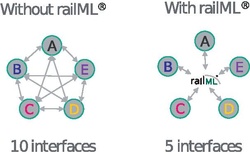| Railway Markup Language | |
|---|---|
 Logo of railML file format | |
| Filename extensions | .railml, .railmlx |
| Internet media type | application/xml, text/xml, application/zip |
| Developed by | railML.org; Dresden / Germany |
| Initial release | 22 December 2005 |
| Latest release | 3.3 5 November 2024 |
| Type of format | Railway exchange format |
| Extended from | XML |
| Standards | Industry standard ISO/TS 4398:2022 |
| Open format? | Yes, CC BY-NC-ND |
| Free format? | Yes |
| Website | www.railml.org |
railML (Railway Markup Language) is an open freeware XML Schema-based data exchange format for data interoperability of railway applications. [1]

